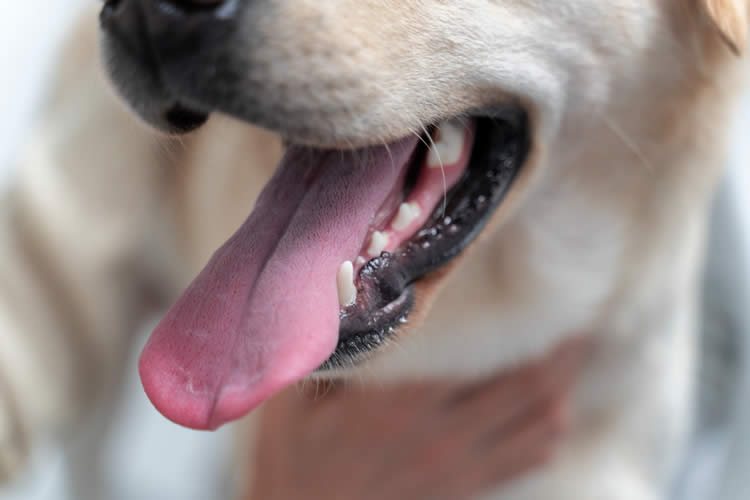An upset stomach in dogs can be triggered by numerous conditions, including bacteria, viruses, parasites, medications, and dietary changes. As a veterinary professional, I’ve seen how these digestive issues often manifest through symptoms like vomiting, diarrhoea, excessive drooling, and concerning lethargy.
However, knowing what to give a dog for upset stomach and vomiting can make a significant difference in their recovery. While a bland diet of boiled chicken and rice often helps soothe their digestive system, some cases may require immediate veterinary attention, especially if symptoms persist beyond two days. We’ll explore effective home remedies, feeding strategies, and crucial warning signs that indicate when professional help is needed.
Recognising Signs of Upset Stomach in Dogs
Spotting the signs of digestive distress in your dog promptly can make a significant difference in their recovery. Dogs can’t tell us when they feel unwell, so learning to recognise their symptoms is essential for providing timely relief.
Common symptoms to watch for
Dogs with upset stomachs typically display a range of digestive and behavioural indicators. The most obvious signs include:
- Vomiting (with or without bile or blood)
- Diarrhoea (may contain mucus or blood)
- Loss of appetite or refusal to eat
- Excessive drooling or salivation
- Increased stomach noises
- Lip smacking or tongue licking
- Passing gas or flatulence
- Abdominal pain (hunched posture or “praying position”)
- Lethargy or decreased energy
Furthermore, your dog might show signs of discomfort by being unable to get comfortable or restless. Some dogs may also experience constipation rather than diarrhoea, which is equally concerning.
Differentiating between mild and severe cases
Most mild stomach upsets in dogs resolve within 24-48 hours. A mild case typically involves occasional vomiting or slightly loose stools without other concerning symptoms. Your dog may remain relatively active and maintain some appetite.
In contrast, severe cases last longer than two days and involve frequent vomiting or watery diarrhoea. Dogs with severe stomach upset often appear visibly unwell, showing marked lethargy and complete loss of appetite. Additionally, they may exhibit signs of dehydration, such as dry gums or “skin tenting” when you gently pull the skin between their shoulder blades.
When vomiting signals an emergency
Certain symptoms demand immediate veterinary attention. Contact your vet straightaway if you notice:
Frequent, repeated vomiting (more than 3-4 times in a day) Non-productive retching or dry heaving Blood in vomit (fresh red blood or “coffee grounds” appearance) Projectile vomiting Vomiting accompanied by abdominal distension or bloating Severe lethargy or collapse Very pale or white gums (indicating possible shock) Black vomit (indicates digested blood)
Notably, certain dogs require extra caution—puppies under six months, senior dogs, and those with pre-existing medical conditions should be seen by a vet sooner if showing digestive distress. Consequently, understanding these warning signs helps you determine whether home remedies for upset stomach are appropriate or professional care is needed.
Safe Home Remedies for Dog Upset Stomach
When your furry friend suffers from an upset tummy, several practical home remedies can provide relief before seeking veterinary care. Understanding these options can help you manage mild digestive issues effectively.
Fasting: When and how long
Temporary fasting allows your dog’s digestive system to rest and heal. For adult dogs with mild vomiting or diarrhoea lasting less than 48 hours, withholding food (but never water) for 12-24 hours can be beneficial. Previously, longer fasting periods were recommended, but current veterinary advice suggests shorter fasting periods followed by gradual reintroduction of food.
Important: Puppies should only fast for approximately 12 hours maximum, as they need regular nutrition for development. Moreover, fasting isn’t appropriate for diabetic dogs, seniors, or those with pre-existing conditions.
Hydration techniques
Preventing dehydration is crucial during digestive upsets. If your dog is vomiting, initially withhold water for about 12 hours, then offer small amounts (¼-½ cup) hourly. For dogs with diarrhoea only, provide continuous access to fresh water.
Try these hydration methods:
- Ice cubes or chips for reluctant drinkers
- Unflavoured electrolyte solutions designed specifically for dogs
- Cooled chicken broth (without salt, fat, or seasonings)
- Plain water with a touch of honey (for non-diabetic dogs)
Bland diet options
After fasting, introduce a bland diet consisting of highly digestible, low-fat foods. The classic option is boiled white chicken meat (no skin or bones) mixed with white rice in equal portions. Both ingredients should be cooked without salt, seasonings, or oils.
Other suitable bland options include plain boiled white fish, scrambled eggs (without butter), low-fat cottage cheese, or plain pasta. Portion control is essential—offer small amounts every few hours rather than regular-sized meals.
Commercial bland diets from veterinary offices provide balanced nutrition for longer recovery periods, unlike homemade options which lack complete nutritional balance for extended use.
Over-the-counter remedies that are safe
Certain OTC medications can be appropriate under veterinary guidance. Famotidine (Pepcid AC) and cimetidine (Tagamet) can help reduce stomach acid. Similarly, bismuth subsalicylate (Pepto-Bismol) may soothe stomach upset in specific situations.
Nevertheless, never administer human anti-nausea medications or painkillers without veterinary approval, as many are toxic to dogs. Additionally, probiotics designed specifically for canines can help restore gut flora after digestive issues resolve.
Despite these home remedies, if symptoms persist beyond 24 hours, worsen, or are accompanied by lethargy, blood in vomit/stool, or decreased water intake, contact your veterinarian immediately.
What to Feed a Dog with Upset Stomach
Providing the right foods for your dog’s upset stomach can significantly speed up recovery. Once fasting is complete, introducing easily digestible options becomes your priority.
Chicken and rice preparation guide
The gold standard for canine digestive issues is a simple chicken and rice mixture. To prepare:
- Start with boneless, skinless chicken breasts (remove all skin and bones)
- Boil the chicken in plain water until fully cooked (15-20 minutes)
- Cook white rice separately using two parts water to one part rice
- Combine chicken and rice in a 1:2 ratio (one part protein to two parts carbohydrate)
- Serve in small portions (2 tablespoons to 1 cup) every 4-6 hours, depending on your dog’s size
Importantly, avoid all seasonings, oils, and butter which can further irritate your dog’s stomach. Gradually reintroduce regular food by mixing 1/4 normal diet with 3/4 bland food for three days, then 1/2 and 1/2 for three days, finally 3/4 regular with 1/4 bland for the last three days.
Pumpkin: Nature’s digestive aid
Pumpkin works wonders for canine digestive issues since it’s rich in fibre that adds bulk to stools. For diarrhoea, pumpkin absorbs water and firms up stools. As a prebiotic, it feeds beneficial gut bacteria whilst inhibiting harmful ones.
Serve 1-4 tablespoons of plain canned pumpkin (not pie filling) depending on your dog’s size. Start with smaller amounts to avoid introducing too much fibre at once. Nearly 97% of dogs showed increased bacterial diversity after pumpkin supplementation.
Bone broth benefits
Bone broth provides excellent nutrition for recovering dogs. This nutrient-rich liquid:
- Soothes and heals the digestive tract
- Supports liver health through amino acids
- Enhances immune system function
- Provides hydration for sick dogs
- Stimulates appetite in reluctant eaters
Prepare by simmering animal bones in water for 20-24 hours, then remove all bones after cooling.
Foods to avoid during recovery
Steer clear of:
- Fatty or oily foods
- Dairy products (can cause diarrhoea)
- Seasoned or spiced foods
- Table scraps or human food
- Foods with additives, sugar or salt
After recovery, transition gradually back to regular meals over 7-10 days to prevent relapse.
When to Seek Veterinary Care
Even with appropriate home care, certain situations demand professional veterinary attention. Recognising these scenarios can make a crucial difference in your dog’s recovery.
Red flag symptoms requiring immediate attention
Contact your veterinarian immediately if your dog shows any of these warning signs:
- Continuous vomiting or retching with nothing coming up
- Blood in vomit or stool
- Bloated or painful abdomen
- Collapse, disorientation, or extreme lethargy
- Pale or white gums (indicating possible shock)
- Signs of dehydration (sticky gums, sunken eyes)
- High or low body temperature (above 102.7°F or below normal)
- Suspected ingestion of foreign objects or toxic substances
Accordingly, breeds prone to bloat require swift medical intervention if showing abdominal distension alongside retching.
Timeline for home treatment before seeing a vet
For mild cases with occasional vomiting or slightly loose stools, home treatment can be attempted for 12-24 hours. Nonetheless, if symptoms persist beyond 24 hours or worsen at any point, professional assessment becomes necessary.
Granted, certain dogs need veterinary care sooner:
- Puppies (under 6 months)
- Senior dogs
- Dogs with pre-existing medical conditions
- Dogs showing multiple symptoms simultaneously
Monitoring hydration is essential throughout home treatment; if your dog cannot keep water down or shows signs of dehydration, postponing veterinary care is risky.
What to expect at the vet visit
Initially, your veterinarian will conduct a thorough physical examination and review your dog’s history. Be prepared to discuss:
- When symptoms started
- What your dog has eaten recently
- Any potential toxin exposure
- Changes in routine or diet
Diagnostic procedures may include:
- Blood tests (complete blood count and chemistry panel)
- Faecal examination
- Urinalysis
- X-rays or ultrasound for suspected obstructions
Treatment varies based on diagnosis but might involve fluid therapy for dehydration, anti-nausea medications, antibiotics for infections, or in severe cases, hospitalisation for intensive care.
Our Final Say!
Understanding dog stomach issues demands careful attention and quick action. While many mild cases respond well to home remedies like fasting and bland diets, serious symptoms require professional care. Throughout my veterinary career, I’ve seen how proper care during the first 24-48 hours often determines the recovery speed.
Most dogs bounce back quickly with appropriate home treatment. Nevertheless, careful monitoring remains essential since seemingly minor symptoms can signal serious underlying conditions. Remember that each dog responds differently to treatment – what works for one might not suit another.
Certainly, prevention plays a vital role in maintaining digestive health. Regular feeding schedules, appropriate portions, and careful monitoring of what your dog eats help avoid many common stomach issues. Should your dog show signs of digestive distress, start with the simple remedies we’ve discussed, but don’t hesitate to seek veterinary help if symptoms persist or worsen.
Above all, trust your instincts as a pet owner. After all, you know your dog best and can spot unusual changes in their behaviour or health. Quick action, whether through home care or professional treatment, gives your furry friend the best chance at a swift recovery.








